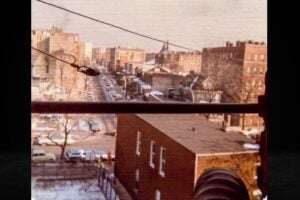
Times Square: Photo- Brian Kachejian 2022 ©
Times Square is undoubtedly one of the best-known places on the planet. After all, it has been featured in countless works, which have created a sort of virtuous cycle. The more Times Square shows up, the more famous it becomes; the more famous Times Square becomes, the more creators want to include it in their works. With that said, Times Square has seen its fair share of ups and downs, which have had a huge effect on its popular image. Arguably, that gives it a sense of character that it would lack if it had just remained eternally unchanging.
Becoming Times Square
Manhattan saw a gradual northward drift in the 19th century. Lower real estate prices fueled much of this movement. Besides that, the process was also facilitated by the building of new transportation infrastructure, which makes sense because the latter makes its surroundings more accessible to interested individuals.
The site of Times Square hosted a mix of farmland and summer homes in the early 18th century. That started to change when it became more accessible to both New Yorkers and out-of-towners thanks to the establishment of a horsecar line in the 1860s and elevated railways in the late 1870s. Unsurprisingly, that kind of connectedness brought about huge changes in the site’s makeup. By the 1870s, it was the center of New York City’s horse carriage industry. That is why it received the name Longacre Square, which was a reference to the center of London’s horse carriage industry. Cafes, restaurants, and other entertainment venues sprouted up on and around the site in the subsequent decades, drawn there by the high volume of regular traffic. The eventual decline of the horse carriage industry because of the advent of motor vehicles just sped up the process.
However, they weren’t the only ones who took an interest. For proof, look no further than The New York Times publisher Adolph Ochs, who inspired the renaming of Longacre Square to Times Square by moving his operations to what is now called One Times Square in 1904. Moreover, he was the one who convinced New York City mayor George McClellan Jr. to build a subway station on the site, which further cemented its position as one of the city’s transportation hubs.
The Establishment of the Theatre District
People started building theaters on and around the site in the late 19th century and early 20th century. Specifically, Oscar Hammerstein was the first to build a theater on the site itself in 1895. After this, other parties built dozens and dozens of theaters from the late 1890s to the late 1920s, thus establishing what is now the Broadway Theater District. Competition played an important role in this process. Some of it was between the theater builders, while the rest was directed toward other forms of entertainment. American entertainment was changing fast in this period, which in turn, meant that the providers of American entertainment were changing fast in close correspondence.
The 1930s and 1940s
Alas, everything changed when the Great Depression struck in late 1929. Subsequently, the United States and the rest of the world went through a decade of economic woes, which hit Times Square hard. Some of its businesses managed to continue running with comparatively few changes. In contrast, others had to find new ways to survive in a market in which the average consumer suddenly had much less spending money but a much-increased need to forget themselves for a time. As a result, Times Square started shifting towards less reputable forms of entertainment in this period. World War Two just strengthened that shift because of soldiers on leave doing what soldiers on leave often do.
The Long Decline
New York City was well-aware that Times Square had a serious issue by the 1950s. Efforts to turn back the hands of time through zoning rules were unfruitful. Instead, the greater permissiveness of the 1960s created new opportunities for the relevant businesses, which was followed by organized crime moving in towards the end of the decade. Thanks to that, the situation worsened throughout the 1970s. Times Square retained its reputation for dynamism. Unfortunately, that dynamism had become something notorious rather than something to be celebrated. Times Square gained a reputation as the place to stay away fro, in the 1970s, especially at night. It was lined with adult theater and shops, The streets helD host to a wide collection of unsavory characters that were looking to take your mnet in many different ways. The film industry lived making crime movies in Time Square. There was no need to build a set, the set was reality. The Martin Scorcese motion picture Taxi Driver perfectly depicted the areas in both the visuals and the commentary performed by the movie’s lead characters Travis Bickel and Iris played by Robert De Niro and Jodie Foster.
Revitalization
Eventually, the trend started changing in the 1980s and 1990s into the 2000s. Much of it was fueled by the efforts of New York’s Mayor Rudolph Giuliani who made it one of his main goals to clean up the area. Widespread concern generated enough will, funding, and other resources for a massive push aimed at revitalizing Times Square. New buildings went up, while old buildings were restored and repurposed. Furthermore, New York City implemented a wide range of measures meant to encourage the right sort of businesses. For example, it used zoning rules to encourage real estate developers to put large, bright signs on their buildings, which would prevent the area from going dark at night. Similarly, security was upped to restrain crime, while pressure was brought to bear on the less reputable sort of businesses. The state of New York even got involved by taking possession of six of nine theaters on 42nd Street before assigning them to a nonprofit organization to oversee their rehabilitation.
Over time, these efforts produced a self-perpetuating loop that revitalized Times Square in much the same way that a different self-perpetuating loop had caused its decline so many decades ago. The presence of family-friendly entertainment venues brought in the right kind of visitors. That encouraged the establishment of more businesses aimed at appealing to these interested individuals, thus encouraging even more of these interested individuals to show up. All while clever marketing, the passage of time, and other factors worked to spread Times Square’s newer, brighter, shinier image in place of its older, more tarnished counterpart.
Times Square in Recent Decades
Thanks to those efforts, Times Square has entered into a brighter period of its existence. Live theater has returned to the forefront of the national consciousness in recent years, which is a reflection of Broadway’s renewed popularity in considerable part. Furthermore, Times Square remains home to other kinds of entertainment, which are now aimed at a different sort of consumer than their predecessors from the 1950s to the 1970s. Examples range from the live broadcasts of Good Morning America to the New York City location of Madame Tussauds. For that matter, Times Square retains its quirkier side, as shown by the street performers who frequent it.
Times Square Street performers have caused many issues in recent years. If you have ever been to Time Square as a tourist who stands out which is probably over half the people who frequent Times Square you will undoubtedly have been approached by a street performer, especially if you have children with you. Kids are mesmerized by the sight of Disney Characters or Marvel Heroes. However, most of these performers are wearing costumes that look like they have not been cleaned in months. Spiderman is a very popular street performer because it’s a cheap custom.
I once posed with a street performer to see what they did to tourists and as soon as my friend took the picture, the street performer handed me a card that read tip $20.00. Street performers have been reigned in lately by the city and zoned to specific areas in Times Square but most of them break the rules every single day. Of course, the most popular and one of the first street performers of the modern era is the singing cowboy who walks around in his underwear playing guitar. His success has spurned on many others in the same genre like singing cowgirls and many other singing cowboys and other scantly clad performers during the warm weather months. Yes, that is Times Square.

Photo: ClassicNewYorkHistory.com ©

Photo: ClassicNewYorkHistory.com
Of course, Times Square continues to change. To name an example, much of the area was transformed into pedestrian plazas in the late 2000s, which was followed by rebuilding from the early 2010s to the mid-2010s. The plan went through based on improving livability, reducing vehicular accidents, and bringing other benefits. It seems safe to say that Times Square will continue to change in the times to come, befitting one of the most dynamic locations in the world.
References:
https://www.timessquarenyc.org/history-of-times-square
https://www.nypl.org/blog/2015/01/12/changing-times-square
Jackson, Kenneth T. The Encyclopedia of New York City. New Haven, CT: Yale University Press, 2011.
Haskell, David. The Encyclopedia of New York. New York: Avid Reader Press, an imprint of Simon & Schuster, Inc., 2020.
History Of Times Square Article: ClassicNewYorkHistory.com ©2022
ClassicNewYorkHistory.com claims ownership of all its original content and Intellectual property under United States Copyright laws and those of all other foreign countries. No one person, business or any organizations is allowed to republish any of our original content anywhere on the web or in print without our permission.






























